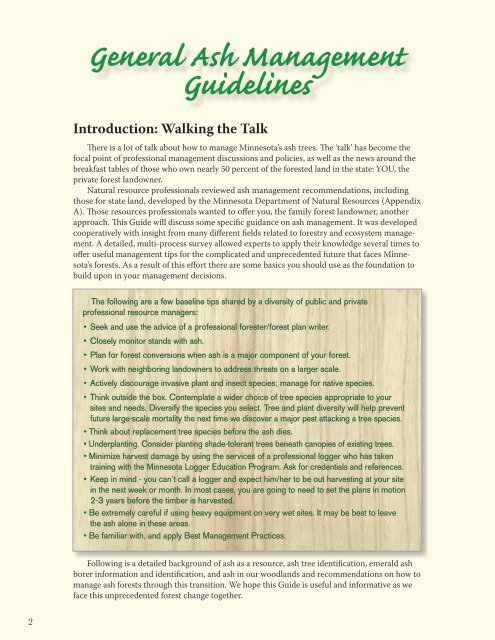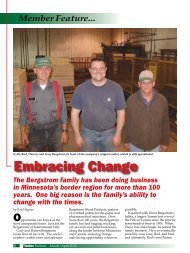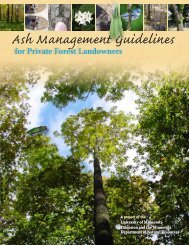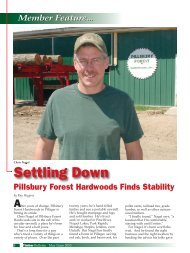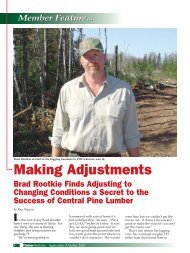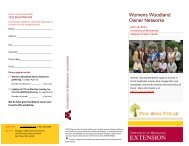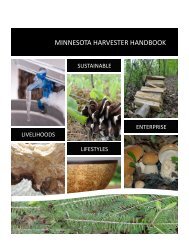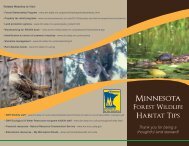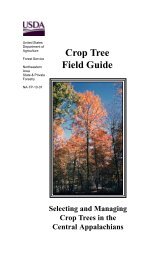Ash Management Guide for Private Forest Landowners
Ash Management Guide for Private Forest Landowners
Ash Management Guide for Private Forest Landowners
Create successful ePaper yourself
Turn your PDF publications into a flip-book with our unique Google optimized e-Paper software.
General <strong>Ash</strong> <strong>Management</strong><strong>Guide</strong>linesIntroduction: Walking the TalkThere is a lot of talk about how to manage Minnesota’s ash trees. The ‘talk’ has become thefocal point of professional management discussions and policies, as well as the news around thebreakfast tables of those who own nearly 50 percent of the <strong>for</strong>ested land in the state: YOU, theprivate <strong>for</strong>est landowner.Natural resource professionals reviewed ash management recommendations, includingthose <strong>for</strong> state land, developed by the Minnesota Department of Natural Resources (AppendixA). Those resources professionals wanted to offer you, the family <strong>for</strong>est landowner, anotherapproach. This <strong>Guide</strong> will discuss some specific guidance on ash management. It was developedcooperatively with insight from many different fields related to <strong>for</strong>estry and ecosystem management.A detailed, multi-process survey allowed experts to apply their knowledge several times tooffer useful management tips <strong>for</strong> the complicated and unprecedented future that faces Minnesota’s<strong>for</strong>ests. As a result of this ef<strong>for</strong>t there are some basics you should use as the foundation tobuild upon in your management decisions.The following are a few baseline tips shared by a diversity of public and privateprofessional resource managers:• Seek and use the advice of a professional <strong>for</strong>ester/<strong>for</strong>est plan writer.• Closely monitor stands with ash.• Plan <strong>for</strong> <strong>for</strong>est conversions when ash is a major component of your <strong>for</strong>est.• Work with neighboring landowners to address threats on a larger scale.• Actively discourage invasive plant and insect species; manage <strong>for</strong> native species.• Think outside the box. Contemplate a wider choice of tree species appropriate to yoursites and needs. Diversify the species you select. Tree and plant diversity will help preventfuture large-scale mortality the next time we discover a major pest attacking a tree species.• Think about replacement tree species be<strong>for</strong>e the ash dies.• Underplanting. Consider planting shade-tolerant trees beneath canopies of existing trees.• Minimize harvest damage by using the services of a professional logger who has takentraining with the Minnesota Logger Education Program. Ask <strong>for</strong> credentials and references.• Keep in mind - you can’t call a logger and expect him/her to be out harvesting at your sitein the next week or month. In most cases, you are going to need to set the plans in motion2-3 years be<strong>for</strong>e the timber is harvested.• Be extremely careful if using heavy equipment on very wet sites. It may be best to leavethe ash alone in these areas.• Be familiar with, and apply Best <strong>Management</strong> Practices.Following is a detailed background of ash as a resource, ash tree identification, emerald ashborer in<strong>for</strong>mation and identification, and ash in our woodlands and recommendations on how tomanage ash <strong>for</strong>ests through this transition. We hope this <strong>Guide</strong> is useful and in<strong>for</strong>mative as weface this unprecedented <strong>for</strong>est change together.2


